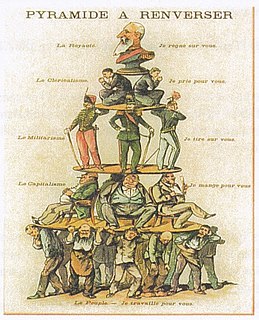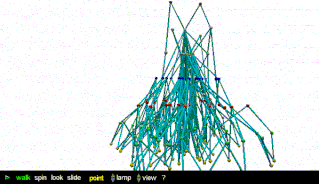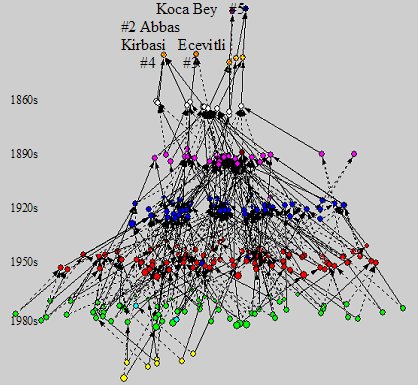
Cultural anthropology is a branch of anthropology focused on the study of cultural variation among humans. It is in contrast to social anthropology, which perceives cultural variation as a subset of a posited anthropological constant. The portmanteau term sociocultural anthropology includes both cultural and social anthropology traditions.

In anthropology, kinship is the web of social relationships that form an important part of the lives of all humans in all societies, although its exact meanings even within this discipline are often debated. Anthropologist Robin Fox says that the study of kinship is the study of what humans do with these basic facts of life – mating, gestation, parenthood, socialization, siblingship etc. Human society is unique, he argues, in that we are "working with the same raw material as exists in the animal world, but [we] can conceptualize and categorize it to serve social ends." These social ends include the socialization of children and the formation of basic economic, political and religious groups.

Structural functionalism, or simply functionalism, is "a framework for building theory that sees society as a complex system whose parts work together to promote solidarity and stability".

Social network analysis (SNA) is the process of investigating social structures through the use of networks and graph theory. It characterizes networked structures in terms of nodes and the ties, edges, or links that connect them. Examples of social structures commonly visualized through social network analysis include social media networks, memes spread, information circulation, friendship and acquaintance networks, business networks, knowledge networks, difficult working relationships, social networks, collaboration graphs, kinship, disease transmission, and sexual relationships. These networks are often visualized through sociograms in which nodes are represented as points and ties are represented as lines. These visualizations provide a means of qualitatively assessing networks by varying the visual representation of their nodes and edges to reflect attributes of interest.

In the social sciences, social structure is the patterned social arrangements in society that are both emergent from and determinant of the actions of individuals. Likewise, society is believed to be grouped into structurally related groups or sets of roles, with different functions, meanings, or purposes. Examples of social structure include family, religion, law, economy, and class. It contrasts with "social system", which refers to the parent structure in which these various structures are embedded. Thus, social structures significantly influence larger systems, such as economic systems, legal systems, political systems, cultural systems, etc. Social structure can also be said to be the framework upon which a society is established. It determines the norms and patterns of relations between the various institutions of the society.

In sociology, social complexity is a conceptual framework used in the analysis of society. Contemporary definitions of complexity in the sciences are found in relation to systems theory, in which a phenomenon under study has many parts and many possible arrangements of the relationships between those parts. At the same time, what is complex and what is simple is relative and may change with time.
Sociocultural anthropology is a portmanteau used to refer to social anthropology and cultural anthropology together. It is one of the four main branches of anthropology. Sociocultural anthropologists focus on the study of society and culture, while often interested in cultural diversity and universalism.
Structural anthropology is a school of sociocultural anthropology based on Claude Lévi-Strauss' 1949 idea that immutable deep structures exist in all cultures, and consequently, that all cultural practices have homologous counterparts in other cultures, essentially that all cultures are equitable.
Meyer Fortes FBA FRAI was a South African-born anthropologist, best known for his work among the Tallensi and Ashanti in Ghana.

Mathematical sociology or the sociology of mathematics is an interdiscplinary field of research concerned both with the use of mathematics within sociological research as well as research into the relationships that exist between maths and society.

Douglas R. White was an American complexity researcher, social anthropologist, sociologist, and social network researcher at the University of California, Irvine.
Sir Edmund Ronald Leach FRAI FBA was a British social anthropologist and academic. He served as Provost of King's College, Cambridge from 1966 to 1979. He was also President of the Royal Anthropological Institute from 1971 to 1975.
Structural cohesion is the sociological conception of a useful formal definition and measure of cohesion in social groups. It is defined as the minimal number of actors in a social network that need to be removed to disconnect the group. It is thus identical to the question of the node connectivity of a given graph. The vertex-cut version of Menger's theorem also proves that the disconnection number is equivalent to a maximally sized group with a network in which every pair of persons has at least this number of separate paths between them. It is also useful to know that k-cohesive graphs are always a subgraph of a k-core, although a k-core is not always k-cohesive. A k-core is simply a subgraph in which all nodes have at least k neighbors but it need not even be connected. The boundaries of structural endogamy in a kinship group are a special case of structural cohesion.

Structural endogamy is a network concept that provides a means of finding the boundaries of endogamy in a community, using simply the genealogical and marriage linkages. The concept is related to that of structural cohesion. The examples are made with free tool Pajek. Another name for structural endogamy is (marital) relinking, which comes out of French social anthropology, and the study of how communities are formed through couples marrying who are already linked: linked, that is, by chains of kinship and marriage, as in circles of intermarrying families, or marriages between people with one or more ancestors in common. Many of the marriages represented in the Turkish nomads figure are with cousins, for example. But relinking also occurs without blood marriages, as in the example from the Mexican village of Belén Atzitzi-mititlán within Apetatitlán de Antonio Carvajal.
Systems theory in anthropology is an interdisciplinary, non-representative, non-referential, and non-Cartesian approach that brings together natural and social sciences to understand society in its complexity. The basic idea of a system theory in social science is to solve the classical problem of duality; mind-body, subject-object, form-content, signifier-signified, and structure-agency. System theory suggests that instead of creating closed categories into binaries (subject-object); the system should stay open so as to allow free flow of process and interactions. In this way the binaries are dissolved.
Social anthropology is the study of patterns of behaviour in human societies and cultures. It is the dominant constituent of anthropology throughout the United Kingdom and Commonwealth and much of Europe, where it is distinguished from cultural anthropology. In the United States, social anthropology is commonly subsumed within cultural anthropology or sociocultural anthropology.
The concept of nurture kinship in the anthropological study of human social relationships (kinship) highlights the extent to which such relationships are brought into being through the performance of various acts of nurture between individuals. Additionally the concept highlights ethnographic findings that, in a wide swath of human societies, people understand, conceptualize and symbolize their relationships predominantly in terms of giving, receiving and sharing nurture. The concept stands in contrast to the earlier anthropological concepts of human kinship relations being fundamentally based on "blood ties", some other form of shared substance, or a proxy for these, and the accompanying notion that people universally understand their social relationships predominantly in these terms.

A social network is a social structure made up of a set of social actors, sets of dyadic ties, and other social interactions between actors. The social network perspective provides a set of methods for analyzing the structure of whole social entities as well as a variety of theories explaining the patterns observed in these structures. The study of these structures uses social network analysis to identify local and global patterns, locate influential entities, and examine network dynamics.

Aparna Rao was a German anthropologist who performed studies on social groups in Afghanistan, France, and some regions of India. Her doctorate studies focused on anthropogeography, ethnology, and Islamic studies. Rao taught anthropology at the University of Cologne, serving for a brief time as chair of the Department of Ethnology at the South Asia Institute of Heidelberg University, Germany.
Ulla Johansen was an Estonian-born German ethnologist.










